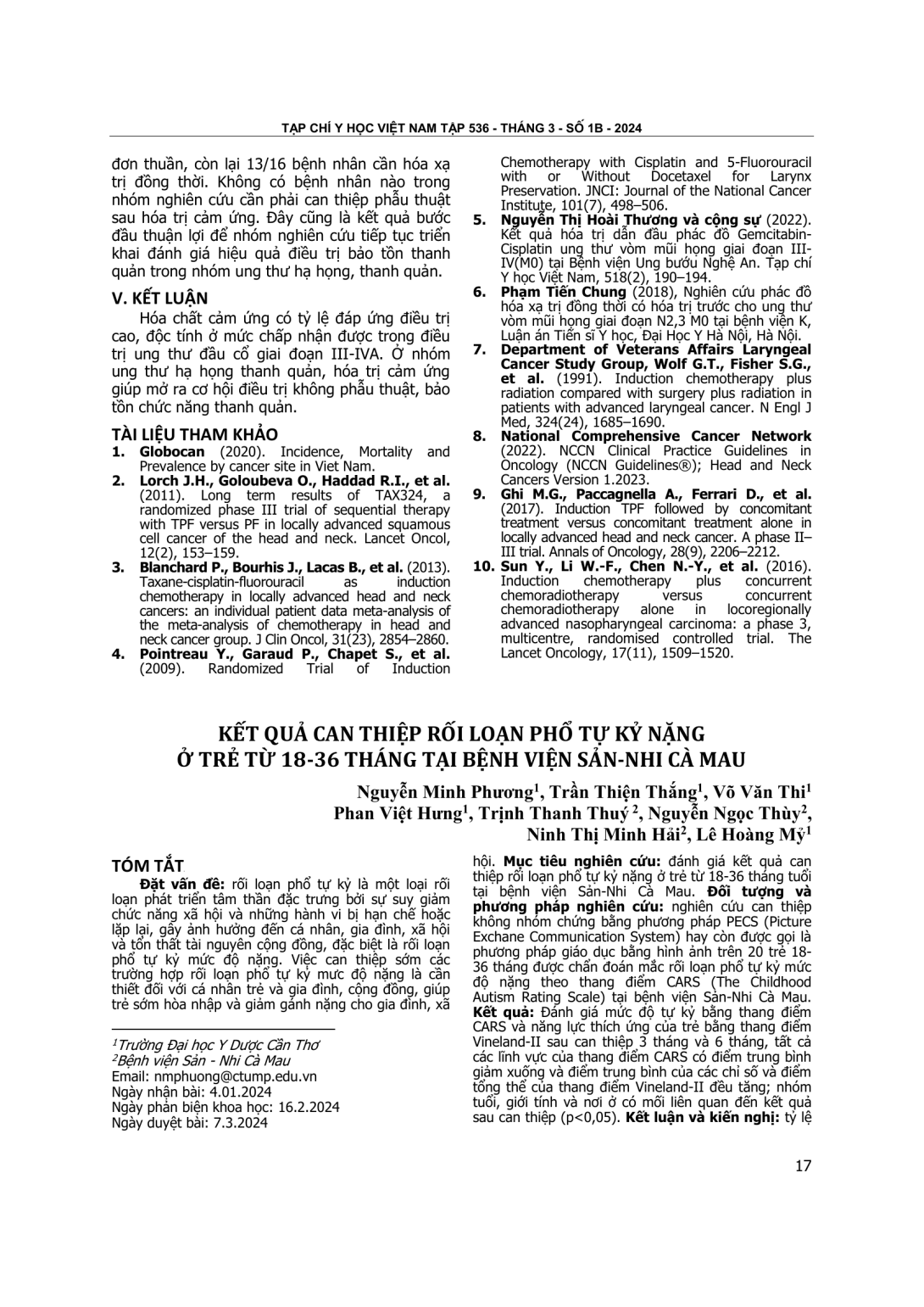
Rối loạn phổ tự kỷ là một loại rối loạn phát triển tâm thần đặc trưng bởi sự suy giảm chức năng xã hội và những hành vi bị hạn chế hoặc lặp lại, gây ảnh hưởng đến cá nhân, gia đình, xã hội và tổn thất tài nguyên cộng đồng, đặc biệt là rối loạn phổ tự kỷ mức độ nặng. Việc can thiệp sớm các trường hợp rối loạn phổ tự kỷ mưc độ nặng là cần thiết đối với cá nhân trẻ và gia đình, cộng đồng, giúp trẻ sớm hòa nhập và giảm gánh nặng cho gia đình, xã hội. Mục tiêu nghiên cứu: đánh giá kết quả can thiệp rối loạn phổ tự kỷ nặng ở trẻ từ 18-36 tháng tuổi tại bệnh viện Sản-Nhi Cà Mau. Đối tượng và phương pháp nghiên cứu: nghiên cứu can thiệp không nhóm chứng bằng phương pháp PECS (Picture Exchane Communication System) hay còn được gọi là phương pháp giáo dục bằng hình ảnh trên 20 trẻ 18-36 tháng được chẩn đoán mắc rối loạn phổ tự kỷ mức độ nặng theo thang điểm CARS (The Childhood Autism Rating Scale) tại bệnh viện Sản-Nhi Cà Mau. Kết quả: Đánh giá mức độ tự kỷ bằng thang điểm CARS và năng lực thích ứng của trẻ bằng thang điểm Vineland-II sau can thiệp 3 tháng và 6 tháng, tất cả các lĩnh vực của thang điểm CARS có điểm trung bình giảm xuống và điểm trung bình của các chỉ số và điểm tổng thể của thang điểm Vineland-II đều tăng; nhóm tuổi, giới tính và nơi ở có mối liên quan đến kết quả sau can thiệp (p<0,05). Kết luận và kiến nghị: tỷ lệ trẻ 18-36 tháng được chẩn đoán rối loạn phổ tự kỷ mức độ nặng sau khi can thiệp có cải thiện, mức độ cải thiện tùy thuộc vào một số yếu tố như giới tính, nơi ở, nhóm tuổi. Các trẻ rối loạn phổ tự kỷ mức độ nặng nên được can thiệp kịp thời, cần có sự phối hợp chặt chẽ giữa gia đình, nhà trường và nhân viên y tế.
Autism spectrum disorder is a type of mental development disorder characterized by impaired social functioning and restricted or repetitive behaviors, causing personal, family, and social impact and loss. community resources, especially severe autism spectrum disorder. Early intervention in cases of severe autism spectrum disorder is necessary for individual children, families and communities, helping children integrate early and reduce the burden on families and society. Objective: evaluate the results of intervention for severe autism spectrum disorder in children aged 18-36 months at Ca Mau Obstetrics and Pediatrics Hospital. Materials and methods: Non-controlled intervention study using the PECS (Picture Exchane Communication System) method, also known as the visual education method, on 20 children 18-36 months old diagnosed with severe autism spectrum disorder according to the scale. CARS score (The Childhood Autism Rating Scale) at Ca Mau Obstetrics and Pediatricss Hospital. Results: Assessing the level of autism using the CARS scale and the child's adaptive capacity using the Vineland-II scale after 3 months and 6 months of intervention, all areas of the CARS scale had a decrease in average score and median score. The average of the indicators and the overall score of the Vineland-II scale both increased; Age group, gender and place of residence are related to results after intervention (p<0.05). Conclusion and suggestion: The proportion of children 18-36 months old diagnosed with severe autism spectrum disorder improved after intervention. The degree of improvement depends on a number of factors such as gender, age and place of residence. Children with severe autism spectrum disorders need timely intervention, requiring close coordination between family, school and medical staff.
- Đăng nhập để gửi ý kiến
